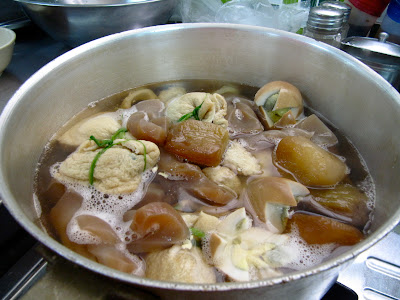Myself, along with the other Worldwide Korea Bloggers that were able to come to the welcoming ceremony for The Korea Blog on Tuesday were welcomed to lunch and some time to look around the Chongwadae Sarangche (청와대 사랑채). We were brought to the Sarangchae restaurant and first were offered two choices for lunch, either bibimbap or bulgogi. I chose the bulgogi as you can see below. I particularly liked the gold dishes and utensils.
After finishing lunch we had some free time to wonder around the museum. The Sarangchae is dedicated to Korean culture, history and explanations of government projects. Above you can see each of Korea's four bills. We had a whole unit in my 사회통합 class last week about these so I'll give you a quick run down.
50,000 won- This woman is called 신사임당 and she lived from 1504-1551. Her claim to fame is being an model wife and mother and rearing her son 율곡 이이, a Confucian scholar who appears on the 5,000 won bill, although it seems she was also an accomplished artist as well.
10,000 won- The man who appears here is none other than 새종대왕 or the great King Sejong who lived from 1397-1450. If you know anything about Korean history, you've probably heard of this guy. He is famous for inventing various things but top on that list is Hangul. He realized that writing in Chinese was impractical and kept the lower class from becoming educated. Unfortunately, though he invented this during his lifetime it's use didn't truly become mainstream until early in the 20th century due to push back from the country's elite.
5,000 won- Here you can see 율곡 이이, the son of 신사임당, a Confucian scholar who lived from 1536-1584. He published many works on philosophy, politics and Taoism.
1,000 won- The face of 퇴계 이황 a contemporary of 율곡 이이 and another important scholar and politician who lived from 1501-1570. He also published many works and served in various political positions under four different kings throughout his lifetime.
As you continue throughout the museum, you can find many interesting photos and information about Korea. Below is a robot that I was hoping to see in action, but it seems to have been charging when we visited.
Another area of the museum that I enjoyed was the presidential hall. You can see photos of each of the presidents throughout Korean history and a hall dedicated to photos and gifts that presidents have received from dignitaries from around the world. There are also several photo ops that are especially fun. Here you can sit at the president's desk.
President 조안나
And even a photo op with the president and his wife right in front of the Blue House!
Lastly, you can experience a little bit of the G20 which was held in Seoul in 2010. Have a seat at a desk or look at some of the photos from the summit which are hung around the room.
Admission to the Chongwadae Sarangchae is free and is within walking distance from Gyongbukgung palace if you're in the area.





















































